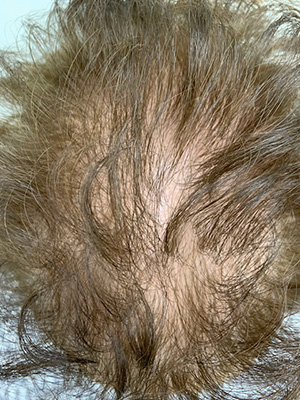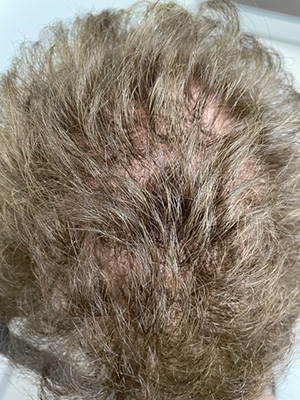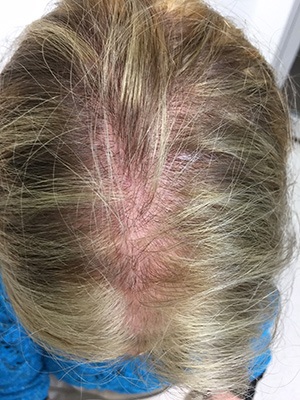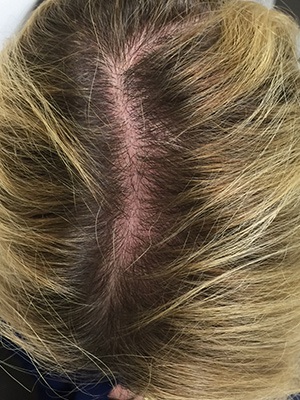Over more than 10 years of work as a dermatologist, hair loss has been the most distressing condition for many female patients. It seems to be surprisingly less so for male patients. There was a study done years ago which concluded; a female finally makes an appointment to see a dermatologist when they have lost at least 50% of their hair.
I am not going to discuss all the possible diagnoses and treatment options available for hair loss as that would mean pages of information which you can find elsewhere. What I hope to do in the next few paragraphs is briefly discuss the most common conditions and my approach if a patient came to see me with hair loss. The information below although presented with the female in mind also applies to male patients with hair loss.
What is a Trichologist?
Trichology (from Greek θρίξ, gen.: τριχός, “hair”) is the branch of dermatology that deals with the scientific study of the health of hair and scalp. A trichologist is usually a doctor who can diagnose the causes of hair loss, diseases of the scalp and treat accordingly. All dermatologists are trichologists but all trichologists are not dermatologists and female hair loss is a particular interest of mine.
What causes female hair loss?
The most common causes of female hair loss I see in my rooms are androgenetic alopecia aka female pattern hair loss (approximately 70%) followed by telogen effluvium, alopecia areata and lichen planus in decreasing order. Hormonal deficiencies and the lack of iron and other nutrients may accelerate this loss.
Female pattern hair loss
Patients have a history of increasing hair shedding when washing or brushing their hair. Their ponytail or bun becoming less full and gradual thinning is noticed especially over the crown. It is normal to lose hair daily however most females seem to realise reasonably quickly that the hair fall has increased and isn’t normal for them. In the early stages, hair loss can be stopped and sometimes reversed with hair appearing thicker after 2-3 years of treatment. If the hair loss is significant at presentation, realistically, we could slow down further loss but reversing the loss is much more difficult.
Tests for cause of hair loss
Firstly, I need to work out why you are losing hair and after examining your scalp will usually ask for
- Blood tests to exclude anaemia, iron, nutritional deficiency and hormonal imbalances.
- Biopsy of the scalp - In some patients, a biopsy (sample of scalp skin) maybe recommended to confirm a diagnosis before starting therapy. It is important to exclude other causes which are treated differently.
Treatment of female pattern hair loss
My approach to hair loss has changed over the years. I believe it is important to be proactive. The aim of treatment is not to just stop further hair loss but to thicken and if possible, reverse the thinning. I would encourage patients to present early to see their doctor or dermatologist.
What is telogen effluvium?
Telogen effluvium is the hair loss which occurs after stress, whether it is after pregnancy, dramatic loss of weight, illness, grief etc. It may sometimes occur without a trigger. This condition can sometimes coexist with female pattern hair loss
What causes bald spots?
Alopecia areata (AA) is the simplest to diagnose and generally doesn’t require a biopsy. Most patients present with bald patches on the scalp which appear suddenly. Generally, if limited to a few areas, then reversal of the condition is simple. However some patients can develop multiple, rapidly enlarging bald areas and in these patients, management is more difficult and realistically some may need to consider wearing a wig. Of all the conditions I manage, AA is the most unpredictable. Fortunately, most patients have rapid improvement and are ecstatic when regrowth occurs.
Scarring hair loss conditions
The most common condition causing scarring hair loss is lichen planus. Patients sometimes notice itching, crusting of the scalp, bald areas or gradual thinning over the crown or frontal scalp (fringe area). When I suspect this condition, a biopsy maybe necessary to confirm the diagnosis and treatment is started immediately. This is important as without treatment, scarring and irreversible hair loss occurs. The aim of treatment is to settle the inflammation asap to minimise any further loss.
Remember if you have a hair loss problem, make time to see your doctor or dermatologist to diagnose and treat it now. Some conditions such as androgenic alopecia, telogen effluvium and alopecia areata are all potentially reversible with treatment. Early diagnosis of scarring or cicatrical alopecia is essential to avoid permanent hair loss.
If you have a hair loss problem, please email us at [javascript protected email address] or contact our rooms for an appointment (teleconsults available).
-
October 2019

-
September 2021

29yo female scalp -April 2015 ( left) and November 2015 ( right)
-
29yo female scalp -April 2015

-
29yo female scalp -November 2015

Finally, the following links will provide more information on the above conditions.
- Androgenic alopecia : www.dermnetnz.org
- Alopecia areata: www.dermnetnz.org
